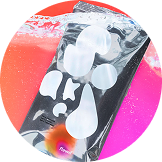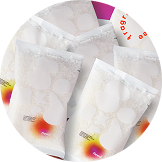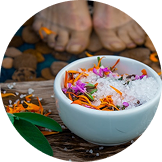Three things in life are promised: death, taxes, and those gut-wrenching cramps that come with your period. Sometimes they’re just uncomfortable, but in many cases, they can be downright debilitating, making it impossible to concentrate at work, exercise, or do anything for that matter.
Even though it’s only a few days a month, there’s no need to suffer in silence. You can ease the pain using some sort of magnesium menstrual cramps solution.
We know what you’re thinking…sounds too good to be true, how does magnesium help with menstrual cramps? This miracle mineral helps relax the smooth muscle of the uterus that causes pain. But reducing period pain is just the tip of the iceberg.
Learn more about magnesium and menstrual cramps below, including which magnesium is best for menstrual cramps and how to take it for the best results. If you just want rapid relief, though, look no further than our magnesium bath soak here at Flewd Stresscare!
Background on Magnesium and Menstrual Cramps
Before we get into the link between magnesium for period cramps, let’s explain what exactly is causing those painful cramps in the first place. This will allow for a better understanding of how magnesium for menstrual cramps can help.
Also known as dysmenorrhea, these are basically contractions of the uterus as it attempts to shed its lining. That’s what your period is in a nutshell. Unfortunately, it can be incredibly painful.
It’s all caused by prostaglandins, hormone-like compounds released during your period that actually trigger these contractions. Some are mild, others are more intense and leave you stuck on the couch with an icepack on your belly hoping the end is near.
But as you may have already experienced yourself, those cramps don’t always stay in the abdomen. Sometimes they can radiate throughout the lower back and thighs. In some cases, they can trigger headaches or digestive discomfort.
The degree to which your cramps cause pain will be influenced by hormonal imbalances, stress, and underlying conditions such as endometriosis.
Periods are frustrating enough without the pain. It feels like Mother Nature rubbing salt in the wound. Fortunately, magnesium for period pain may be able to help.
Magnesium influences more than 300 enzymatic processes. Its roles span from muscle function to nerve signaling, energy production, and much, much more.
Unfortunately, more than half of the population is chronically deficient in magnesium. This can manifest in symptoms such as constant muscle soreness, stress, fatigue, difficulty focusing, and many more.
The good news? Addressing this deficiency can be as simple and enjoyable as indulging in a carefully formulated magnesium bath soak recipe a few times a week. More on that later on. First, does magnesium help with period cramps?
Does Magnesium Help With Menstrual Cramps?
The short answer is yes, using magnesium for period cramps can be a powerful way to find relief. But let’s get more specific - why does magnesium help with menstrual cramps? There are three key magnesium menstrual cramps connections we want to highlight.
Easing Muscle Spasms and Cramps
You know that period cramps are caused by intense contractions of the uterus as it sheds its lining. You also know that magnesium can help ease spasms and cramps throughout the human body in general. It stands to reason this would apply to the smooth muscle tissue of the uterine lining as well.
Magnesium acts as a calcium antagonist - which basically means it prevents calcium from going into overdrive and triggering prolonged muscle contractions. The end result is relaxation, not only reducing the intensity of cramping but also easing muscle spasms.
Reducing Inflammation
Inflammation is part of what causes period pain, and this can be traced to elevated prostaglandins while menstruating. Fortunately, magnesium helps regulate the production of these problematic, inflammatory compounds.
It keeps them at a more moderate level to stop inflammation at the sources, minimizing swelling and tenderness in the lower abdomen. In general, magnesium supports a healthy bodily inflammatory response, which helps you recover faster and feel better quicker.
Improving Mood and Energy
Now, how does magnesium help menstrual cramps beyond managing the physical discomfort they’re notorious for producing? It also helps keep your emotions and energy levels in check.
Your cycle sends your hormones into a frenzy. That’s probably not news to you. But, these mood swings, irritability, and fatigue can all throw a wrench in your life and interfere with your day-to-day lifestyle.
Magnesium helps smooth out these hormonal fluctuations by supporting serotonin production, a neurotransmitter linked to mood regulation and feelings of well-being.
That’s not all, though. Magnesium menstrual cramp solutions can also help reduce cortisol, the stress hormone. How does magnesium help with stress exactly?
Anxiety tends to skyrocket during menstruation, for obvious reasons. But magnesium can bind to GABA (gamma-aminobutyric acid) receptors in the brain to enhance its calming effects.
From an energy perspective, magnesium aids in energy production at the cellular level, easing fatigue and combating the lethargy that is so common during menstruation.
Which Magnesium is Best for Menstrual Cramps?
The relief that comes with using magnesium for period cramps is undeniable. There are plenty of studies pointing to its ability to calm discomfort, while helping manage other symptoms you may encounter on your cycle - irritability, fatigue, anxiety, etc.
However, not all magnesium for menstrual cramps is created equal. Which magnesium is BEST for menstrual cramps? We’ll share three different choices along with forms we suggest you steer clear of below. But the absolute best magnesium menstrual cramps form is magnesium chloride.
Magnesium Chloride
This is the most bioavailable form of magnesium, which speaks to how easily your body can absorb and use the mineral. Low bioavailability means most of it is going to be excreted as waste rather than used to mitigate period pain.
Magnesium chloride works wonders for relaxing uterine muscles, reducing inflammation, and soothing period discomfort. It also supports hydration and balances electrolytes to really help your body recover during menstruation.
We’ll talk more about this later on, but we specifically recommend a topical magnesium chloride supplement. This means you’ll apply the product to your skin rather than take a capsule or mix up a powder.
Magnesium Citrate
Magnesium citrate is another suitable option, but it’s not quite as bioavailable as magnesium chloride. While it still has its place, you’re wondering which magnesium is best for menstrual cramps, and it’s not this one.
Part of why it falls short is its natural laxative effect. Chances are you’re already experiencing digestive discomfort during your cycle, and this can make matters worse.
Magnesium Glycinate
Magnesium glycinate is also highly bioavailable, and is considered more gentle on the digestive system than magnesium citrate. What makes it unique is it’s bound to glycine, an amino acid known for its calming properties.
In this sense, magnesium glycinate can work exceptionally well for managing mood swings and anxiety often associated with PMS. it’s a one-two punch for reducing physical period pain and the mental turmoil that often follows.
Forms of Magnesium to Avoid
You can save yourself any uncertainty by just sticking with magnesium chloride. But, are there any forms you should avoid altogether? Definitely.
Magnesium oxide, for example, has poor bioavailability. So does magnesium sulfate, which is the common form found in epsom salts. We wrote a comparison of magnesium soak vs epsom salt discussing its shortcomings.
How Much Magnesium for Menstrual Cramps?
Each form of magnesium has its strengths, but for fast-acting, targeted relief from menstrual cramps, magnesium chloride is the best choice. But, how much magnesium for menstrual cramps should you be consuming for rapid relief?
Recommended Daily Dosage
There’s no one-size-fits-all dosage for daily magnesium intake during menstruation. The sweet spot will depend on your age and gender along with how deficient you are.
Most adult women can safely consume 310-320 mg per day on their cycle. This is slightly higher than standard daily suggestions, but this is because your body needs more of it during this time of the month.
Timing and Frequency
Properly using magnesium for period cramps actually starts before you feel the pain set in. The goal is to have your magnesium stores stocked up in advance so that the pain is mitigated beforehand. We suggest taking more magnesium a few days before your cycle begins.
If you do end up relying on an oral supplement, make sure you’re taking it with food to optimize absorption and reduce the risk of tummy troubles. For healing bath recipes with magnesium, try to soak every other day while on your period and relax for at least 15-20 minutes.
Signs of Overuse
Magnesium is generally considered safe when you use a quality supplement as directed. However, there are a few signs you’re overdoing it. Watch out for diarrhea, nausea, and abdominal discomfort, particularly with oral forms like magnesium citrate.
Transdermal magnesium, such as bath soaks, has a lower risk of overuse because your skin absorbs only what it needs. This is why in comparing topical magnesium vs oral, using a soak or lotion is way better.
That being said, let’s share some more specific tips on taking magnesium for menstrual cramps.
Our Advice on Taking Magnesium for Period Cramps
We said from the start of this magnesium menstrual cramps conversation that the solution is simple: harness the magnesium soak benefits from Flewd Stresscare.
Our soaks are the safest and most effective way to use magnesium for period cramps, and for a seemingly endless array of other ailments for that matter. Here’s why oral supplements won’t deliver the relief you’re looking for, and why the best magnesium bath soak is worth it.
Why Oral Supplements Fall Short
We talked a lot about bioavailability above. Although magnesium chloride is the most easily absorbed by the body, even it falls short when consumed orally.
The body ends up excreting most of it as waste. Even the relief you do feel is delayed since it takes time for the magnesium to work its way from the digestive system into the bloodstream and then into the muscles where it’s needed most.
But more concerningly, oral magnesium supplements cause side effects that only make period pain worse, from bloating to diarrhea. Fortunately, there’s a better way to use magnesium for period cramps.
Benefits of Bath Soaks
So, what is a bath soak? This is not to be confused with a bath bomb, which is really just a way to spice up your baths with fun, fizzy colors and aromas. In comparing a bath soak vs bath bomb, one actually yields therapeutic results.
This is because bath soaks use the most bioavailable form of magnesium. Wait, does magnesium soak into skin? Yep - especially when combined with warm water to open your pores up.
This method bypasses the digestive system, providing faster relief from cramps and tension without the risk of gastrointestinal side effects.
Here at Flewd Stresscare, we’ve developed a variety of formulations to help you alleviate period pain and all the discomfort that comes with your cycle, from our muscle bath soak to our anxiety bath soak and stress relief bath soak.
Aside from magnesium, we’ve included potent vitamins like A, D, B12, other minerals like zinc, and nootropics. Each plays an important role in supporting a more comfortable menstrual cycle.
Each is carefully crafted with 99% natural ingredients that stop stress at the source and provide relief for up to 5 days. They’re vegan, cruelty-free, biodegradable, and non-toxic.
With a 4.9 star rating and 100,000 happy customers and counting, it’s worth taking a chance on Flewd Stresscare soaks if you want to find relief. We’ll walk you through how to use bath soak below.
How to Use Flewd Stresscare Soaks
We’ve designed our soaks to be as easy to use as possible. No guessing games about how much bath soak to use. Just fill your tub with warm (not scalding hot) water and dump the entire contents in. Let them swirl around, and then immerse yourself in the tub.
How long to soak in magnesium bath is up to you, but we recommend at least 15-20 minutes - 30 minutes if you can handle it. During this time you can focus on mindfulness or meditation, read a book, or listen to a podcast. Light candles and set the stage for relaxation.
You don’t have to rinse off (or worry about the soaks staining your tub, one of the many disadvantages of bath bombs) afterward thanks to natural ingredients. However, you can still do so if you’d like.
Other Topical Forms of Magnesium
If you don’t have time in your routine for a bath or want to supercharge the benefits of magnesium for menstrual cramps, you can rely on other topical solutions as well.
Magnesium sprays or lotions are both great options, especially because you can target the cramps right where you feel them the most. Massage the product into your skin and let it work its magic. Remember which magnesium is best for menstrual cramps - magnesium chloride.
Dietary Sources of Magnesium
It’s a good idea to get in the habit of eating magnesium-rich foods, whether you’re menstruating or not. It’s important to build up your magnesium stores over time so you’re consistently stocked up on this vital mineral.
Leafy greens, nuts, seeds, whole grains, and dark chocolate are excellent sources that help maintain adequate magnesium levels. Incorporate these on a regular basis.
More Ways to Manage Period Pain
Beyond using a magnesium menstrual cramps solution, there are plenty of other ways you can find solace during this time of the month. Here are some of our personal favorites:
- Heat therapy: A heating pad or warm compress can help relax tense muscles.
- Hydration: Staying hydrated prevents water retention and bloating, common period complaints.
- Exercise: Light activity like yoga or stretching promotes circulation and can alleviate cramps.
- Stress management: Incorporating meditation or deep-breathing exercises can help reduce cortisol levels, which contribute to cramping.
But, so many women are finding relief using our magnesium menstrual cramps soaks. You can too. Order today and feel the difference they can make in your cycle firsthand!
Bringing Our Magnesium Menstrual Cramps Guide to a Close
So, does magnesium help with menstrual cramps? The answer should be clear as we wrap up our guide to using magnesium for menstrual cramps. This mineral works to alleviate tension, reduce inflammation, and support healthier hormone balance and energy levels.
Just keep in mind which magnesium is best for menstrual cramps - magnesium chloride is the most bioavailable and well-tolerated. Ideally, you’d use magnesium for period cramps in a topical form, like through our soaks.
Our blog has additional resources like homemade bath soak for sore muscles without epsom salt, are hot baths good for sore muscles, can stress cause muscle soreness, does a hot bath help anxiety, how does taking a bath relieve stress, and is magnesium soak good for you.
Periods are inevitable, but the pain doesn’t have to be. Spoil yourself with the comfort and self-care awaiting you in each and every soak at Flewd Stresscare. Discover the power of magnesium for your next cycle!
























































